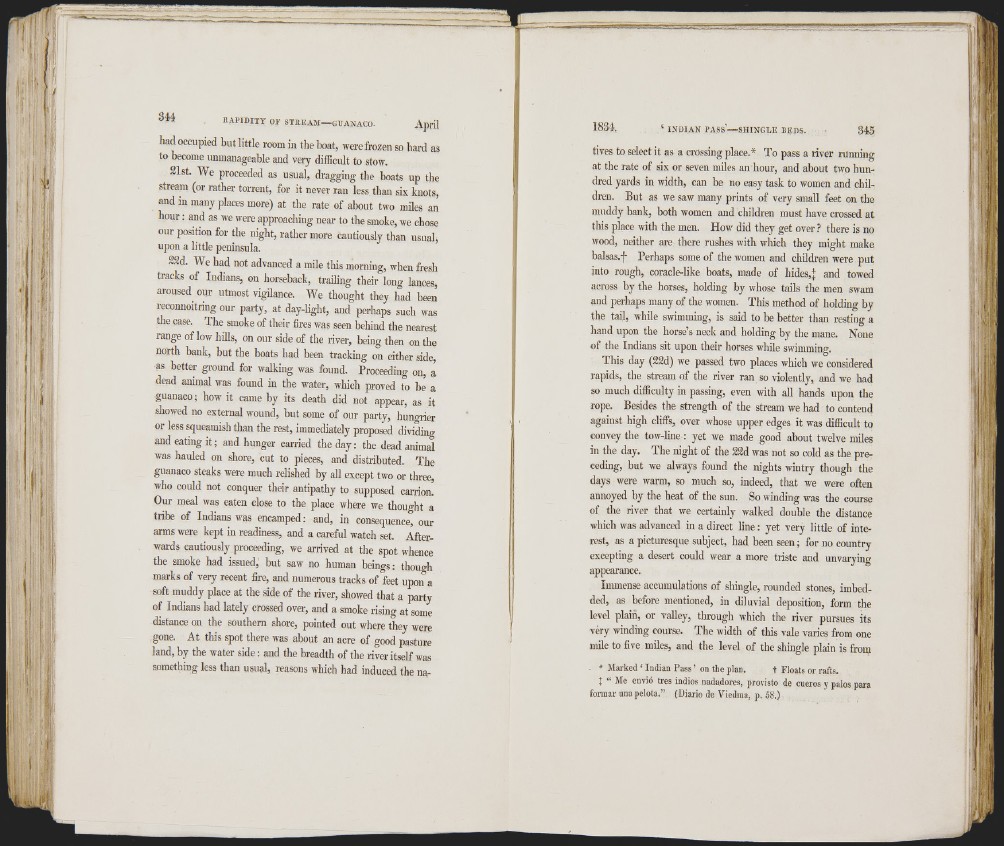
j iii’ j
i . , 1
P0
r i
844 r a p i d i t y o f s t r e a m GUANACO April
had occupied but little room in the boat, were frozen so hard as
to become unmanageable and very difficult to stow.
Slst. We proceeded as usual, dragging the boats up the
stream (or rather torrent, for it never ran less than six knots,
and in many places more) at the rate of about two miles an
hour; and as we were approaching near to the smoke, we chose
our position for the night, rather more cautiously than usual,
upon a little peninsula.
22d. We had not advanced a mile this morning, when fresh
tracks of Indians, on horseback, trailing their long lances,
aroused our utmost vigilance. We thought they had been
reconnoitring our party, at day-light, and perhaps such was
the case. The smoke of their fires was seen behind the nearest
range of low hills, on our side of the river, being then on the
north bank, but the boats had been tracking on either side,
as better ground for walking was found. Proceeding on, a
dead animal was found in the water, which proved to be a
guanaco; how it came by its death did not appear, as it
showed no external wound, but some of our party, hungrier
or less squeamish than the rest, immediately proposed dividing
and eating i t ; and hunger carried the day: the dead animal
was hauled on shore, cut to pieces, and distributed. The
guanaco steaks were much relished by aU except two or three,
who could not conquer their antipathy to supposed carrion!
Our meal was eaten close to the place where we thought a
tribe of Indians was encamped: and, in consequence, our
arms were kept in readiness, and a careful watch set. Afterwards
cautiously proceeding, we arrived at the spot whence
the smoke had issued, but saw no human beings: though
marks of very recent fire, and numerous tracks of feet upon a
soft muddy place at the side of the river, showed that a party
of Indians had lately crossed over, and a smoke rising at some
distance on the southern shore, pointed out where they were
gone. At this spot there was about an acre of good pasture
land, by the water side; and the breadth of the river itself was
something less than usual, reasons which had induced the na‘
INDIAN pa s s ’ SHINGLE BEDS.
tives to select it as a crossing place.* To pass a river running
at the rate of six or seven miles an hour, and about two hundred
yards in width, can be no easy task to women and children.
But as we saw many prints of very small feet on the
muddy bank, both women and children must have crossed at
this place with the men. How did they get over ? there is no
wood, neither are there rushes with which they might make
balsas.f Perhaps some of the women and children were put
into rough, coracle-like boats, made of hides,] and towed
across by the horses, holding by whose tails the men swam
and perhaps many of the women. This method of holding by
the tail, while swimming, is said to he better than resting a
hand upon the horse’s neck and holding hy the mane. None
of the Indians sit upon their horses while swimming.
This day (22d) we passed two places which we considered
rapids, the stream of the river ran so violently, and we had
so much difficulty in passing, even with all hands upon the
rope. Besides the strength of the stream we had to contend
against high cliffs, over whose upper edges it was difficult to
convey the tow-line : yet we made good about twelve miles
in the day. The night of the 22d was not so cold as the preceding,
but we always found the nights wintry though the
days were warm, so much so, indeed, that we were often
annoyed by the heat of the sun. So winding was the course
of the river that we certainly walked double the distance
which was advanced in a direct line: yet very little of interest,
as a picturesque subject, had been seen; for no country
excepting a desert could wear a more triste and unvarying
appearance.
Immense accumulations of shingle, rounded stones, imbedded,
as before mentioned, in diluvial deposition, form the
level plain, or vaUey, through which the river pursues its
véry winding course. The width of this vale varies from one
mile to five miles, and the level of the shingle plain is from
. * Marked ‘ Indian Pass ’ on the plan. + Floats or rafts.
I “ Me envió tres indios nadadores, provisto de cueros y palos para
formar una pelota.” (Uiario de Viedma, p. 58.)